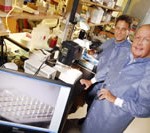In the Star Trek series, Dr. McCoy could often instantly diagnose someone’s condition with the aid of his tricorder. Medicine on 21st century Earth has not advanced quite this far, but scientists’ ideas of how to use “metabolomics†are heading in this direction.
What is metabolomics? Just as genomics means reading the DNA in a person or organism, and assessing it and comparing it to others, metabolomics takes the same approach to all the substances produced as part of the body’s metabolism: watching what happens to food, drugs and chemicals we are exposed to in the environment.
This means dealing with a huge amount of information. Human genomes may be billions of letters (base pairs) in length, but at least there are only four choices of letter!
A recent article in Chemical & Engineering News explores this concept of the “exposome” and quotes Dean Jones. He and his colleagues recently described how they can use sophisticated analytical techniques to resolve thousands of substances in human plasma. Jones is the director of the Clinical Biomarkers Laboratory at Emory University School of Medicine. The paper is in the journal Analyst, published by the Royal Society of Chemistry.
Using a drop of blood, within ten minutes the researchers can discern more than 2,500 substances in a reproducible way. One fascinating tidbit: when they compared the metabolic profiles for four healthy individuals, most of the “peaks†were common between individuals but 10 percent were unique.
The potential uses for this type of technology are staggering.
Jones reports he has been working with researchers at Yerkes National Primate Research Center to discern early signs of neurodegeneration in transgenic monkeys with Huntington’s disease. He has been collaborating with clinical nutrition specialist Tom Ziegler to examine how diet interacts with oxidative stress, and with lung biology to identify markers for fetal alcohol exposure in animal models.









